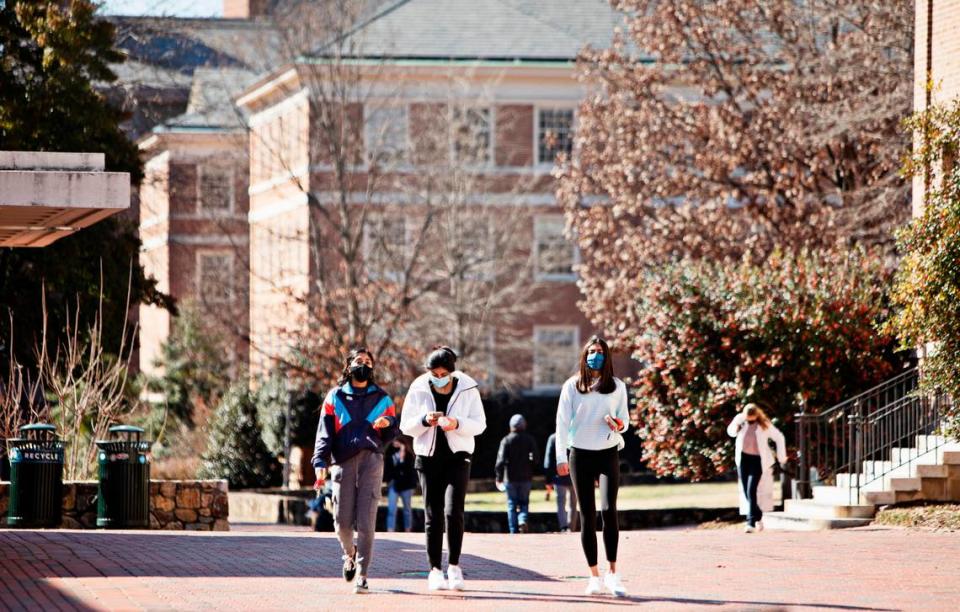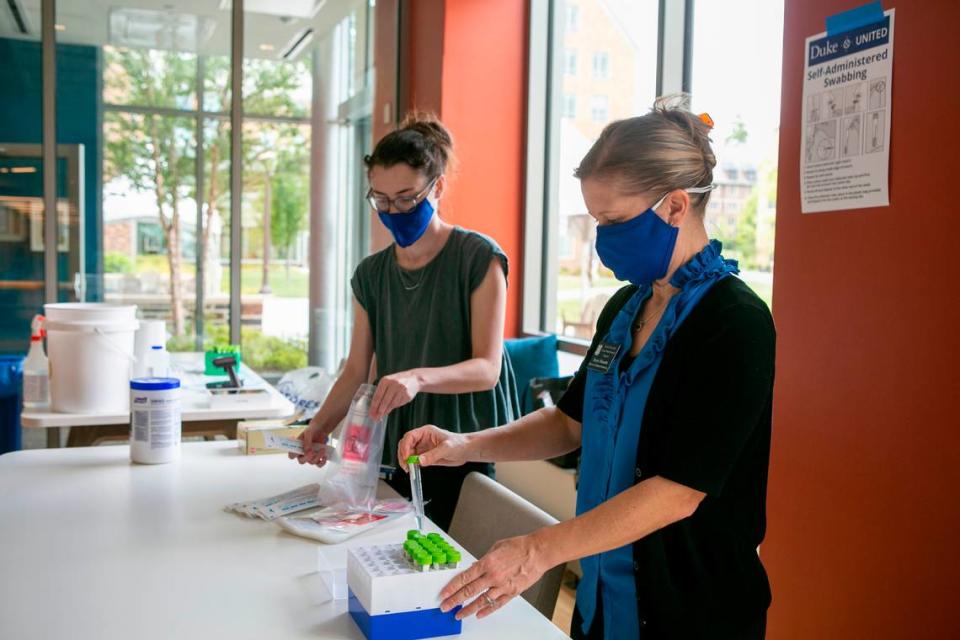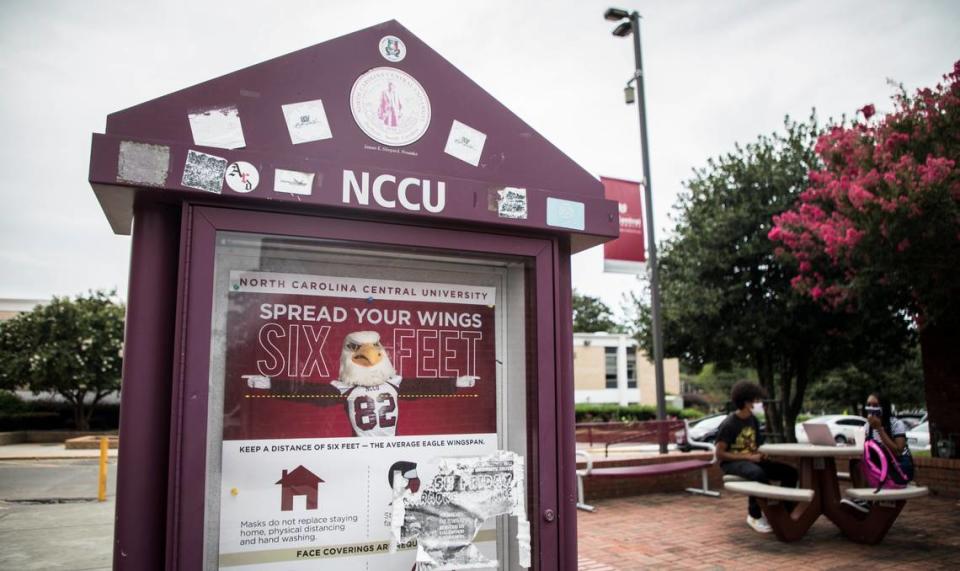COVID isn’t spreading on NC college campuses now like it did last fall. Here’s why.
There was no doubt that universities would see hundreds of COVID-19 cases among students and employees in the spring semester. But campuses haven’t so far seen the drastic spikes in daily case counts or large clusters — even after students rushed Franklin Street, threw large off-campus parties and started in-person classes.
Though some campuses are reporting COVID-19 case numbers similar to or higher than last fall, those cases aren’t spreading as rapidly or widely among students.
Campus administrators and health experts say frequent testing and early detection have helped manage the COVID-19 pandemic on campuses. So far, local universities have been able to operate as planned, with students living in dorms and taking classes on campus this spring.
And university leaders are hopeful this is setting the stage for a more normal fall semester.
A little over a month into the spring semester, here’s a look at COVID-19 cases on NC campuses.
UNC-Chapel Hill
Since January, UNC has reported 610 students and 153 employees have tested positive, according to the UNC COVID-19 dashboard. That includes results from re-entry testing, campus testing and local testing sites. UNC has reported four clusters of about two dozen cases in campus dorms, indicating that most cases are among students off-campus.
About a month into the fall semester, UNC reported nearly 1,000 cases among students and employees and 13 clusters after canceling in-person classes and closing dorms.
“Campus health was somewhat overwhelmed at the start of the fall,” UNC Chancellor Kevin Guskiewicz said. “We realized that it didn’t need to be that way.”
Guskiewicz said they knew there would be cases on campus this spring, but he testing program has been key to their success in keeping campus open.
“We’re able to identify cases sooner and to mitigate the spread of the virus, and we’ve seen very few clusters,” Guskiewicz said. “In addition to that, it’s given our campus community confidence, and that was going to be important to start the semester.”
The ramped up testing and enforcement of community standards are also key as UNC prepares for what summer and fall semesters might look like, he said.

UNC required re-entry COVID-19 testing for students and set up three sites around campus and its own testing lab to do mass asymptomatic testing of students and employees. UNC tests all undergraduate students living on campus and in Chapel Hill or Carrboro at least once a week, which is about 14,000 tests weekly.
Dr. Amir Barzin, a family medicine physician at the UNC School of Medicine, is leading the Carolina Together testing program for the spring semester.
A student or employee who has COVID-19 could be asymptomatic for several days and spread the virus without knowing, Barzin said. Now, with this testing program, they can catch those individuals earlier, go into dorms to test other students quickly, deliver test results within 24 hours and get students isolated and quarantined.
“So that’s the difference, I think, in being able to control the vast spread of this,” Barzin said.
Students, faculty and the Chapel Hill community have been concerned about this spring, particularly after reports of large parties and 1,000 students rushing Franklin Street when UNC men’s basketball beat Duke.
There was a slight increase in cases at the end of January, with about 30 new daily cases for a few days, but that’s gone down to an average of 6 new daily cases in February. There was no spike in cases in the two weeks following the Franklin Street rush or since in-person classes began.
Barzin said normally they would expect to see “peaks or valleys” within a week or two after an event. But, the constant testing means students may have been tested two or three times in the time leading up to that point and there isn’t a big window for them to spread it unknowingly.
NC State University
NC State’s COVID dashboard gives a more real-time snapshot of cases in the university community.
Since Jan. 1, 996 students and 297 employees tested positive for COVID-19, which includes results from campus and local testing sites and re-entry testing.
Over the past 7 days, NC State has reported about 16 new daily cases, mostly among students.
This month, NCSU has reported a few spikes of 50 or more new daily cases, with the highest daily count among students at 62 new cases on Feb. 5.
Dr. Julie Casani said those spikes are likely related to testing loads on those days, which are typically right before the weekend. Casani is the director and medical director of Student Health Services at NC State.
NC State has kept its campus isolation and quarantine space open and available so far this semester, a stark difference from the fall.
NCSU hasn’t had more than two dozen students in isolation or quarantine on campus in the past 10 days. About 40 beds on campus are being used, which is 13% of the total capacity.
Off-campus, however, as many as 113 students were in isolation and more than 200 students in quarantine at one time.
That’s a fairly small number compared to August when nearly 1,000 students were in isolation or quarantine at one time off-campus and nearly half of the on-campus space was occupied.
Last fall, NC State closed dorms and moved classes online after early spikes in cases.

Casani credits their success with good compliance from students, less students in residence halls and classrooms, comprehensive testing and quick isolation of positive cases and overall lower community transmission rates.
“We’re really not seeing spreading,” Casani said. “We’re seeing cases, but we’re not seeing clusters.”
NC State also hasn’t seen any spikes in cases after particular violations by students, like it did in the fall with spread at off-campus gatherings and clusters in Greek Village.
Duke University
Duke has seen more cases in the first few weeks of the spring semester than it did overall last fall, but the university is still on track to keep students on campus.
At Duke, 263 students and 134 employees have tested positive since Jan. 3, a 0.25% positivity rate, according to Duke’s COVID-19 dashboard.
The university has completed more than 156,000 tests, including asymptomatic, symptomatic and contract traced students and employees, as well as entry testing. Duke is conducting an average of about 22,000 tests per week and has 29 active cases among students and employees.
Nearly 1,000 students have been in precautionary quarantine after they’ve been identified through contact tracing or voluntarily reported that they are quarantining because of symptoms, possible exposure, travel or family circumstances.
Last fall, 152 students and 89 employees tested positive throughout the entire fall semester, including entry testing, out of nearly 180,000 tests.
Duke University was praised by for its COVID-19 testing program last fall, which included entry testing and mass testing of asymptomatic students and employees. It kept positive cases relatively low and managed the spread to keep students living on campus and attending in-person classes.

Duke saw a spike in cases at the beginning of January and campus administrators were concerned. In early February, Duke issued a warning to students threatening to move all classes online and having students stay in their apartments or rooms except to get food.
The university is not approaching that situation right now, according to Assistant Vice President of Media Relations & Public Affairs Erin Kramer. She noted that Duke’s numbers are still about 1 in 1,000 for positive cases.
Over the weekend, the university sent a warning message to undergraduate students about an off-campus party that the Durham Police Department reported at least 50 unmasked Duke students attended.
Duke reminded students that hosting large scale social events is a flagrant violation of university COVID-19 expectations and violates state and local rules. Those students could face disciplinary action, including loss of campus privileges and a two-semester suspension.
While Duke’s COVID-19 cases are higher than last semester, university spokesperson Mike Schoenfeld said the university is not seeing “cases spreading.”
Duke reported 11 students testing positive last week out of more than 10,000 tested and six of them were from one group of graduate students who were together. The university has also reported a few other clusters among students living off-campus and attending birthday parties.
NC Central University
NC Central University, a historically Black institution in Durham, tested all students when they returned to campus this spring and the university has done surveillance testing of students throughout the semester.
Since January, 75 students and 24 employees and 6 subcontractors have tested positive, according to NCCU COVID data. That number reflects individuals who have had contact with the campus within 14 days of their confirmed diagnosis.
By comparison, NCCU reported 104 students, 39 employees and 9 contractors tested positive between July 1 and Dec. 31 2020. NCCU kept dorms open and classes in-person last fall.

East Carolina University
East Carolina reported 483 cases among students and 77 cases among employees since Jan. 3, according to the ECU COVID-19 dashboard. There were a few spikes in cases in late January, with a high of 38 new daily student cases, but there’s been a steady decline since then.
In the past week, ECU reported 24 new cases out of more than 1,500 tests and a moving daily average of 6 new cases.
Last fall, ECU didn’t require testing for all students who were back in Greenville, and the school mostly just tested students with symptoms. When cases spiked in August, the university was forced to move classes online and told students to move out of dorms.
This spring, ECU required re-entry testing for all students living on campus and is doing surveillance testing each week throughout the semester.
Appalachian State University
Appalachian State reported two clusters on campus and 321 cases among students and 27 among employees since Jan. 1, according to the App State COVID-19 dashboard. It shows new daily cases are still on the rise in Boone.
The university has completed 12,791 tests on campus and reports a 2.1% positivity rate.
Last fall, App State faced pressure to move classes online and close dorms after cases spiked, 25 clusters were reported and a student died from COVID-19. But the university never made the switch.
This spring, App State required residential students to get tested before coming to campus and is doing mandatory surveillance testing of athletes, residential students and other students.

